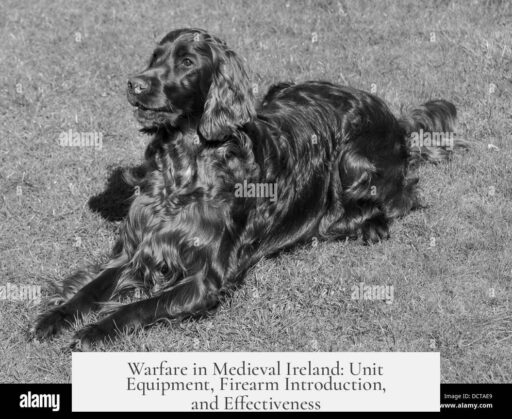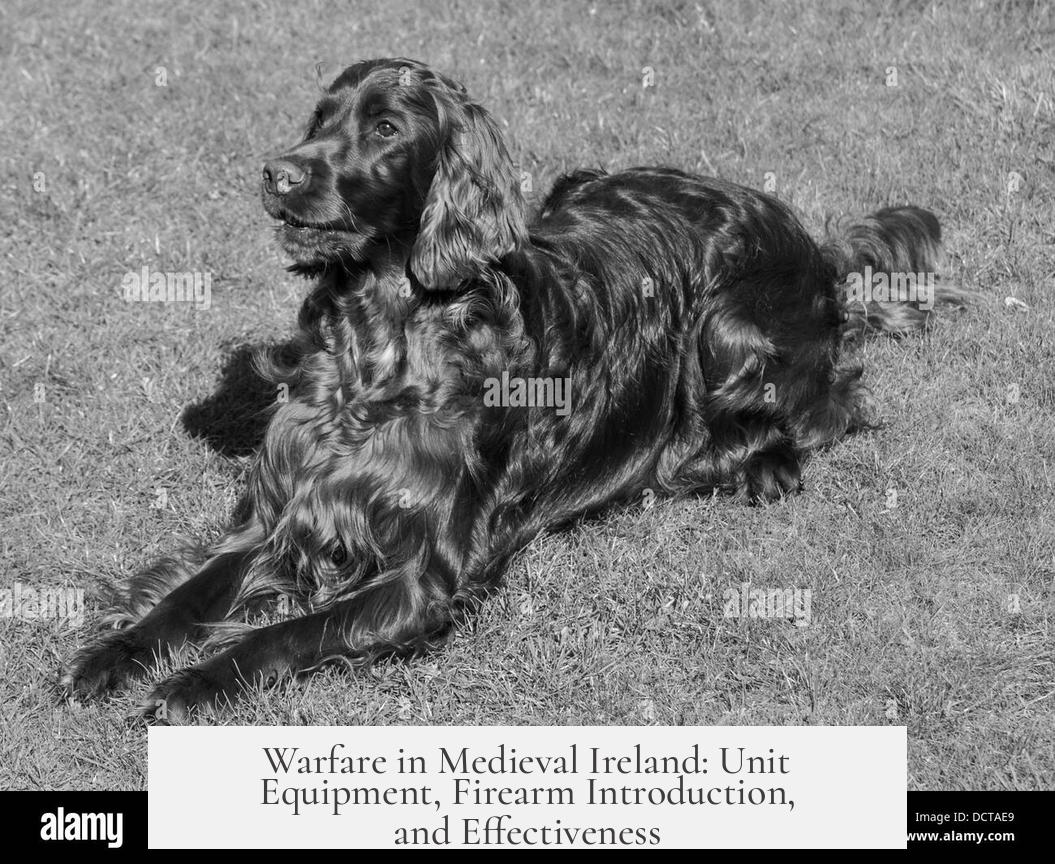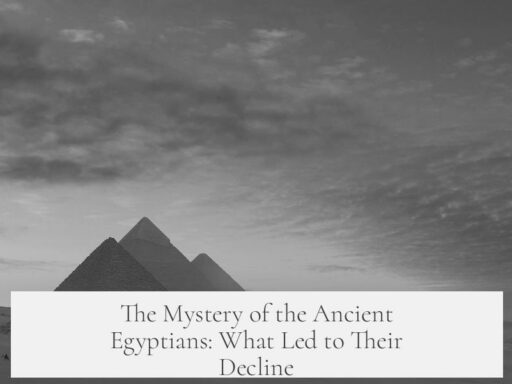Warfare in Ireland during the Middle Ages centered on light infantry and raiding tactics, with units like kerns and gallowglasses serving distinct roles. Firearms were introduced late and became significant only during the Tudor reconquest, eventually transforming Irish military strategies.
The primary infantry consisted of kerns (ceithearn). These light troops fought mainly as skirmishers, relying on speed and surprise rather than heavy armor. Kerns were typically independent farmers or minor landowners who bore arms as a mark of status in Gaelic society. There were two kern types: the buanna, mercenaries hired locally or abroad, and farmers conscripted by their lords during campaigns.
Kerns carried short spears, throwing darts similar to javelins, axes, and small wooden shields called targets. They also used bows with barbed arrows. Descriptions from English observers during the Tudor period highlight their skill at dart-throwing and light armament, such as swords and targets. Their clothing included belted saffron tunics, a traditional color tied to social rank in Gaelic Ireland.
Irish conflict strategy largely relied on raids and ambushes. Kerns excelled at guerrilla warfare, winning most ambushes due to speed and surprise. However, in pitched battles against disciplined English forces, they often lost unless attacking an enemy on the march or in camp. The Irish used war cries and horns to create noise before charging, throwing spears then engaging in close combat with swords or long daggers. Their style resembled ancient Gallic tactics, combining intimidation with mobility.
Gallowglasses emerged in the 14th century from Scottish mercenaries. They formed a heavy infantry core supporting light troops. These men were heavily armored and wielded large axes. Though relatively few in number, they served as bodyguards and backed up kerns in battle. Their presence introduced a more robust infantry element contrasting with the otherwise lightly armed Irish forces.
Irish cavalry were lightly equipped, focusing on mobility rather than heavy armor or shock tactics. Their role was limited compared to the heavy cavalry also fielded by English armies, which contributed to Irish difficulties facing the latter.
| Unit | Role | Equipment | Tactics |
|---|---|---|---|
| Kerns | Light infantry/skirmishers | Short spears, darts, small shield, light sword, bow and arrows | Ambushes, raids, guerrilla warfare, fast movement |
| Gallowglasses | Heavy infantry/mercenaries | Heavy armor, large axes | Backup force, bodyguards, close combat support |
| Light Cavalry | Mobile reconnaissance and raiding | Light equipment, likely spear or sword | Fast movement, flanking |
Before the late Middle Ages, Irish warfare did not feature gunpowder weapons. The arrival of firearms coincided with the Tudor reconquest in the 16th century. At this time, Irish forces began to adopt pike and shot formations influenced by continental tactics. Musketeers mixed with pikemen formed units equipped with a combination of firearms and melee weapons.
Irish adoption of firearms was sometimes more wholehearted than the invading English armies. Some units reportedly relied fully on firearms, marking a shift away from traditional weapons like bows and darts. This change allowed for a more flexible and modern approach to warfare, though firearms remained limited by availability and training.
Despite the introduction of gunpowder weapons, Irish warfare retained its clan-based, decentralized character. The widespread use of castles, along with English heavy cavalry and infantry, created a strategic environment unfavorable to traditional Irish tactics. Firearms helped level this imbalance somewhat, allowing local forces to contest English advances with new technology.
Firearms were not ubiquitous but increased steadily in use during the 16th century. They proved effective in siege warfare and battles. Pike and shot tactics gave Irish and English forces a mixed-arms approach, combining ranged firepower with close-quarter defense. Overall, firearms transformed Irish warfare from primarily light infantry skirmishes toward more organized and modern military formations.
- Early medieval Irish warfare focused on light infantry (kerns) using spears, darts, bows, and swords.
- Gallowglasses emerged by the 14th century as heavily armored mercenary infantry, wielding large axes.
- Irish tactics emphasized raids and ambushes, excelling in guerrilla warfare but struggling in pitched battles.
- Light cavalry supported raids but lacked the power of English heavy cavalry.
- Firearms arrived during the Tudor reconquest (16th century), introducing musketeers and pike formations.
- Irish troops sometimes relied fully on firearms, using them effectively in late medieval conflicts.
- The introduction of firearms marked a shift toward modern warfare but did not fully unify fragmented Irish forces.
What Was Warfare Like in Ireland During the Middle Ages and How Were Different Units Equipped? Also, When Were Firearms Introduced, How Frequently Were They Used and How Effective Were They?
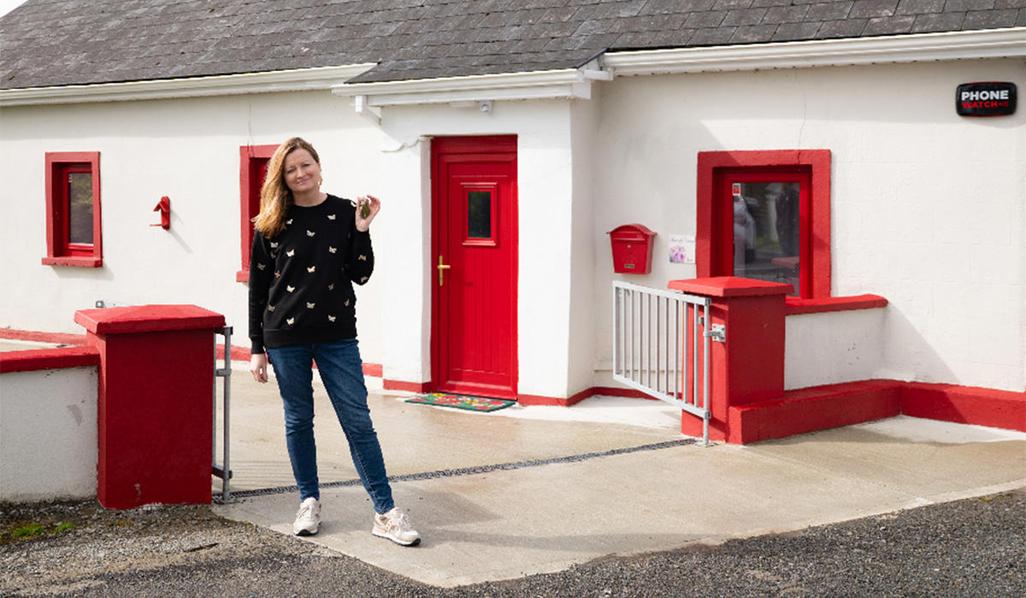
Warfare in medieval Ireland was a patchwork of light skirmishes, quick ambushes, and occasional heavy infantry battles. The native Irish prized swift raids and guerrilla tactics executed predominantly by lightly armed troops called kerns, while heavier units, like the famous gallowglasses, arrived later from Scotland to provide muscle. Firearms, meanwhile, didn’t make a strong entrance until the Tudor reconquest, by which time gunpowder weapons began reshaping Irish military forces.
Let’s dive into the heart of what made Irish medieval warfare unique, how they armed their soldiers, and how the advent of guns rewrote battle strategies.
The Backbone of Irish Warfare: Kerns and Their Nimble Combat Style
Picture the average Irish fighter during the Middle Ages. More often than not, he was a kern (or ceithearn)—a lightly armed, swift, and agile foot soldier. Kerns mostly came from independent farmers or landowners, because in Gaelic society being able to bear arms wasn’t just practical, it was a social badge.
The kern’s arsenal was quite modest by European standards. According to an English observer during the Tudor reconquest, these soldiers carried just a sword paired with a small wooden shield called a target, or sometimes a bow and a quiver of barbed arrows. Others threw darts, a type of javelin, with remarkable skill.
Gerald of Wales even notes that Irish warriors ventured into battle wielding short spears, axes, and those deadly darts. Their clothing? A saffron-colored tunic, tied at the belt—an important social symbol restricting what colors one could wear.
The kern was a guerrilla warrior: a raider striking from the shadows rather than standing toe-to-toe in large battles. Ambushes, quick forays to seize cattle or settle blood feuds, and hit-and-run tactics defined their approach. This style worked wonders against other Irish clans but failed spectacularly against the well-drilled English forces laden with heavy cavalry and imposing fortresses.
Enter the Gallowglasses: Heavy Infantry from Scotland
From the 14th century, Scotland sent over mercenaries known as gallowglasses. These men were Ireland’s first taste of disciplined heavy infantry since Caesar’s legions toured Europe, albeit more casually. Gallowglasses were bulky, heavily armored, and wielded hefty axes that could cleave through shields and helmets alike.
Though relatively few in number, they served a crucial tactical role. Typically positioned in the rear, gallowglasses backed up the skirmishing kerns when battles escalated into serious melees. Imagine them as the “cozy backup squad” who would crash the party once the light troops had stirred up trouble.
Their armor and weaponry set them apart from the lightly equipped Irish foot soldiers, making them the heavy hitters—physically and psychologically—especially in close combat.
And Let’s Not Forget the Light Cavalry

Compared to English knights, Irish cavalry were featherweights. They bore light arms and moved quickly—suited for swift raids and hit-and-run tactics, not heavy charges. This reflected the overall mobility-focused Irish style, which prioritized speed and surprise over brute force.
Warfare as a Reflection of Gaelic Society
Medieval Ireland wasn’t a unified battlefield but a cluster of small kingdoms ruled by chieftains and clans. So the chaos extended beyond foreign invasions to internal rivalries. These clans often waged wars over cattle raids, family feuds, or power plays. The lack of a unified front made organized resistance to English incursions difficult.
When the English arrived wielding castles, plate-armored cavalry, and organized infantry, Irish forces found their hit-and-run style ill-equipped to shoulder such siege warfare and conventional battles.
How Did Irish Equipment Compare?
| Unit | Role | Armament & Equipment | Tactics |
|---|---|---|---|
| Kerns (Ceithearn) | Light infantry/skirmishers | Sword, small wooden shield (target), bows with barbed arrows, short spears, darts, axes; saffron tunics | Raids, ambushes, guerrilla warfare |
| Gallowglasses | Heavy infantry/mercenaries | Heavily armored, wielding large axes | Backup support, close combat |
| Light Cavalry | Reconnaissance, raids | Lightly armed and armored | Fast attacks, harassment |
When Did Firearms Enter the Irish Battlefield?
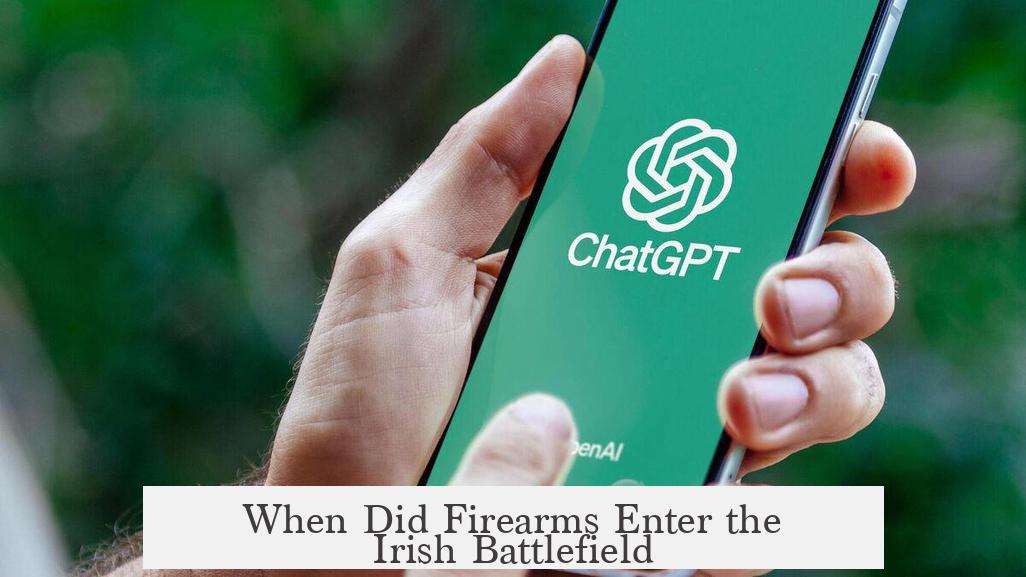
For centuries, Irish warfare stayed relatively the same. The familiar blend of kern raids and gallowglass muscle defined the battlefield up to the 16th century. However, the Tudor reconquest ushered in a game-changer: widespread gunpowder weapons.
During the late medieval and early Tudor period, the Irish began adopting the continental European military model — mixing musketeers with pikemen and swordsmen. These “pike and shot” formations became part of Irish armies, showing their ability to adapt when circumstances demanded.
Interestingly, during this period, Irish forces sometimes used firearms more extensively than the invading English. There are accounts suggesting that certain Irish units placed “full reliance on firearms,” signalling a shift from traditional arms to gunpowder technology.
How Effective and Frequent Were Firearms?
Firearms increased the lethality and changed the dynamics of Irish warfare. Muskets, though slower to reload and less accurate than modern guns, had a psychological impact and could penetrate armor that axes or arrows found challenging.
Nonetheless, firearms didn’t instantly replace traditional weapons. They supplemented existing arms within mixed units. Their use grew over time, becoming more frequent as training improved and manufacturing increased.
By the late 16th and early 17th century—towards the end of the medieval era—firearms’ role became significant enough to alter battle outcomes. This transition helped Irish armies resist, at least partially, heavily armed English forces.
What Lessons Can We Take from Irish Medieval Warfare?
- Terrain and tactics matter: The Irish leveraged their knowledge of local geography for raids and ambushes, allowing light troops to disrupt heavier, slower foes.
- Adaptability is key: After centuries of traditional fighting, Irish forces embraced new military tactics and firearms during the Tudor period.
- Unity makes strength: The fragmented Irish political landscape was a major hurdle against stronger invaders with centralized armies.
Final Thoughts
Medieval Irish warfare is a story of light-footed skirmishing kerns, steadfast Scottish gallowglass warriors, fragmented political clans, and an eventual—though gradual—embrace of gunpowder weapons. It is a portrait of a society fighting to preserve its ways amid encroaching medieval modernity.
So next time you imagine Irish warriors charging into battle, don’t just picture swords and axes. Think of dart-wielding farmers in saffron tunics slipping through the woods, then reinforced by heavy Scottish mercenaries, and finally by the crack of early firearms echoing across the rolling hills.
Would the Irish have coordinated better earlier with firearms? Could their ambush tactics have adapted fully to counter castles and English heavy cavalry? Those are questions to ponder. What’s certain is that their military story is richer and more complex than many outsiders imagine.
